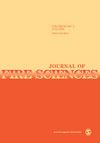Brominated flame-retardant composition in firefighter bunker gear and its thermal performance analysis
IF 1.9
4区 工程技术
Q2 ENGINEERING, MULTIDISCIPLINARY
引用次数: 3
Abstract
Firefighting bunker gear is manufactured from flame-retardant materials, which resist ignition and delay flame spread. However, concerns have been emerging on the potential harmful effects of some flame retardants (FRs) commonly used in flame-retarding materials, particularly the brominated flame retardants. This study investigated the presence of flame retardants in bunker gear, particularly polybrominated diphenyl ethers and their congeners in the garments, and evaluated their impact on thermal performance. X-ray fluorescence spectroscopy was used to ascertain the presence of bromine as a possible indicator for brominated flame retardants. X-ray fluorescence results indicated the presence of Br in all samples, ranging from 444 to 20,367 µg/g. Further analysis via gas chromatography–mass spectrometry was done on samples. Brominated flame retardants, particularly polybrominated diphenyl ethers and hexabromocyclododecane, were detected in all samples with concentrations ranging from 261.61 to 1001.77 µg/g and 0.01 to 0.07 µg/g, respectively. The cone calorimeter was used, with 50 and 75 kW/m2 heat fluxes, to investigate the impact of the brominated flame-retardant concentrations, if any, on thermal performance. New bunker garments, particularly those with lower Br and brominated flame-retardant concentrations, were observed to have higher thermal performance.消防员方舱装备中溴化阻燃剂的组成及其热性能分析
消防舱齿轮采用阻燃材料制造,具有抗着火、延缓火焰蔓延的作用。然而,阻燃材料中常用的一些阻燃剂,特别是溴化阻燃剂的潜在有害影响已引起人们的关注。本研究调查了燃料箱装备中阻燃剂的存在,特别是多溴联苯醚及其在服装中的同系物,并评估了它们对热性能的影响。用x射线荧光光谱法确定溴的存在,作为溴化阻燃剂的可能指示剂。x射线荧光结果表明,所有样品中都存在Br,范围为444至20,367µg/g。通过气相色谱-质谱法对样品进行进一步分析。在所有样品中检测到溴化阻燃剂,特别是多溴联苯醚和六溴环十二烷,浓度分别为261.61至1001.77µg/g和0.01至0.07µg/g。使用热流为50和75 kW/m2的锥形量热计来研究溴化阻燃剂浓度(如果有的话)对热性能的影响。新的防弹衣,特别是那些含有较低Br和溴化阻燃剂浓度的防弹衣,被观察到具有更高的热性能。
本文章由计算机程序翻译,如有差异,请以英文原文为准。
求助全文
约1分钟内获得全文
求助全文
来源期刊

Journal of Fire Sciences
工程技术-材料科学:综合
CiteScore
4.00
自引率
0.00%
发文量
14
审稿时长
2.5 months
期刊介绍:
The Journal of Fire Sciences is a leading journal for the reporting of significant fundamental and applied research that brings understanding of fire chemistry and fire physics to fire safety. Its content is aimed toward the prevention and mitigation of the adverse effects of fires involving combustible materials, as well as development of new tools to better address fire safety needs. The Journal of Fire Sciences covers experimental or theoretical studies of fire initiation and growth, flame retardant chemistry, fire physics relative to material behavior, fire containment, fire threat to people and the environment and fire safety engineering. This journal is a member of the Committee on Publication Ethics (COPE).
 求助内容:
求助内容: 应助结果提醒方式:
应助结果提醒方式:


